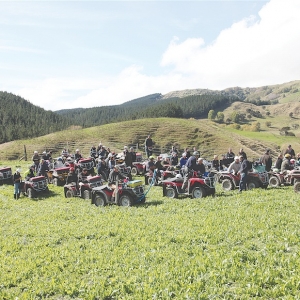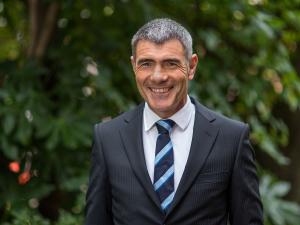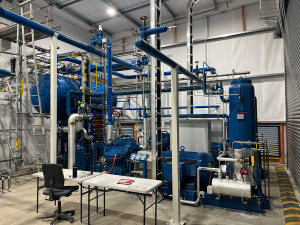“Three species breed and finish here and they are all here for a reason,” says Hawke’s Bay monitor farm programme facilitator Phil Tither. “Though it does create a complexity that makes farming more difficult.”
Plenty of potential exists with the deer, but to date they haven’t been earning much of a margin, he says, “partly because of the current venison market, but primarily because of animal performance and we want to lift that. We’ve culled, focusing on reproductive performance, so we see deer numbers easing a little or at best holding, until those performance levels come up.”
The target is a 25% ratio of deer breeding and finishing (now 24%) to sheep 50% and cattle 25%.
Ten years ago Anawai ran 1850 breeding hinds. That is now much reduced, says farm manager Colin Davis.
“Five years ago we moved away from the wapiti as terminal sires because we were struggling to get our R2s or mature herd hinds to perform. We now have eastern red stags to try to lower that sexual maturity rate: the eastern reds tend to conceive more in the first cycle.”
The spikers are joined with R1 hinds early January for social reasons. “We haven’t always achieved it, but last year we achieved virtually 100% weaning pre–rut. The stag went out on March 14 this year, later than we would have liked. We’ll target March 1 next year.”
Fawns are weaned in paddocks using Tim Aitken’s weaning policy where they go back into the paddocks they were reared in (Aitken technique) then once settled are moved to the Maraetotara platform for finishing.
Last year’s drought proved a challenge for all areas on the farm and the deer were no exception.
Feed demand was high during this time and the decision was made to put 760 hinds into the forestry block with 600 tonnes of dry matter in a self-feed silage pit towards the end of the rut.
“In hindsight that was a mistake,” says Tither. “We won’t do it again. The stags dominated and kept the hinds from going to the pit. Self-feed works fantastically in the winter and is not a bad policy, but not in autumn.”
During the drought they also fed maize to deer – expensive but important for deer health and it kept them going until pastures recovered.
This year R1 and R2 hinds will be wintered on a kale crop and 50% of mixed-age hinds will be grass rotated. Another 50% will go onto the silage pit in the forestry block in winter.
Finishing in late summer and autumn will be done on crops of Lucerne, plantain and clover.
Stock control has been improved by putting in strengthened internal deer fencing to create an ideal fawning environment. And 1900m of seven-wire electric deer fence have enabled cross species grazing on the lucerne.
Speaking at a field day in April, Tony Pearse, producer manager for Deer Industry New Zealand (DINZ) says the most important time to get young stock up to their threshold weights is during lactation and in early autumn.
“We recommend monitoring the fawn’s growth profile during lactation,” he explained. “One thing the industry has learned is the weight of the young animal on June 1 determines the subsequent slaughter pattern. It is hard to change and expensive to feed for limited gain during winter by luxury feeding and once you have hit spring the growth pattern is pretty much determined. Adequate winter feeding is however still important to reduce stress and maintain animal health and wellbeing.”
The deer industry produces young animals 12 months of the year for a consumption season of just four months – October to January in most of our markets.
“Deer are such seasonal animals: they normally hit their 15-month weight and don’t grow for the next six months,” Pearse adds. “That is slightly out of phase with the market requirements, so the big push has been for more deer on the ground heavier and earlier for flexibility in the first 12 months of life. Now, as the yield and carcase traits are starting to be assessed, we also want them better as well as heavier and earlier.”
Anawai’s farming operation, land type and mix of breeding and finishing country is similar to a focus farm in North Canterbury owned by Sam and Mark Zino.
Pearse suggested some of the methods used there could be applied at Anawai to help them capture the lucrative chilled venison market and therefore lift profit margins.
Extending the fawning season and weaning and growing deer to their optimum weights before June 1 would help them achieve this.
“The key areas in lifting liveweight gains and carcase weights and therefore advancing the kill are the improved autumn liveweight gains by means of a focus on quality feed,” Pearse says.
Modern technology offers various means of monitoring and managing animals but, overall, feed levels drive production. “That’s no secret to anyone,” he explains.
“Our advice to deer farmers is to also take up the technology about monitoring pasture covers, do feed budgeting and understand the seasonality of your animals.”

















